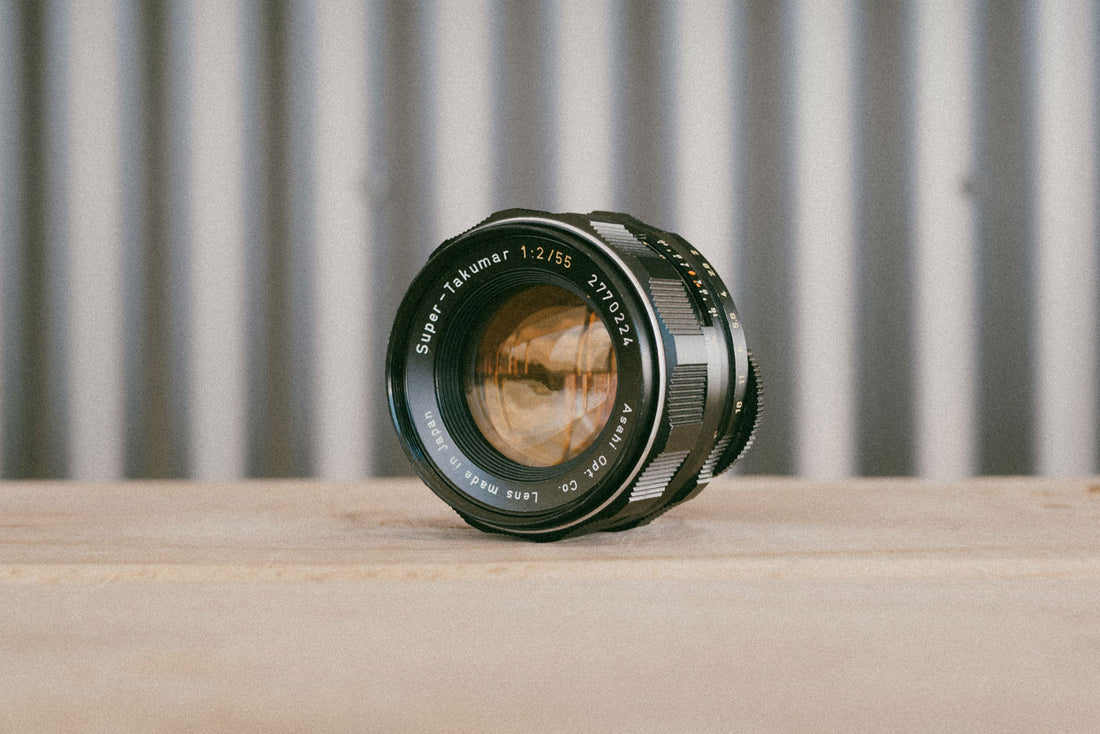Manual focus lenses - there is a fair bit of hype around them these days, especially as newer manual focus options enter the market from brands like TTArtisan and 7Artisans. However, there are some purists out there - like myself - who favour going old school, and adapt vintage lenses to digital cameras to create a new shooting experience.
Why Adapt Vintage Lenses to Digital Cameras?

Adapting vintage lenses to digital cameras has gained popularity for several reasons. Vintage lenses offer unique character and aesthetics, often missing in modern lenses.
I know a lot of people talk about lenses being ‘clinically sharp’. While clarity is obviously something greatly appreciated, I think there comes to a point where photography is too perfect, too clean, too sharp. For me, that’s where a nice manual focus lens comes in.
Because of the different technology used to produce them, they have more character than modern lenses. They produce distinctive colors, dreamy bokeh, and a nostalgic feel straight out of the camera. Another bonus (if you ask me) is that most of the time, they tend to be cheaper than autofocus lenses. This means they’re a budget-friendly way to experiment with photography!
How to Adapt Vintage Lenses to Digital Cameras
To use vintage lenses on digital cameras, you need an adapter that matches the lens mount to your camera's mount. Adapters are widely available and easy to use, making the adaptation process easy to do
Mirrorless cameras are particularly well-suited for this due to their shorter flange distances, which make them compatible with a wider range of vintage lenses compared to DSLRs
Because these vintage lenses have no electrical bits for autofocus, your camera may not fire the shutter as it thinks there is no lens attached. You may need to poke about for a ‘release shutter without lens’ setting. This will vary according to your camera’s model, so I’ll leave it up to you to check your camera for this!
Cons of Adapting Vintage Lenses
If you prize portability, vintage glass can be a bit larger in comparison to native lenses for your camera, depending on the size of the adaptor needed. Depending on the lens, this can add extra bulk to your camera. While there are some, such as the Industar 50mm f/3.5 that are incredibly small for their focal length, you might still find adding vintage lenses to your camera reduces ease of carry.
For example, while I love the photos that my Helios 44-2 58mm f/2 creates, I think it definitely sticks out a bit from my camera - especially since it narrows down at one part. It sticks out really strangely, if you ask me!

Common Vintage Lens Mounts
Several vintage lens mounts are commonly adapted to digital cameras. You’ll need to make sure that yo know which lens mount adapter to buy, so pay attention when shopping for lenses. These include:
M42 Screw Mount
The M42 screw mount was the ‘universal mount’ for many years and almost all camera brands have lenses in the M42 mount! The most common brand you’ll see is Pentax, but you’ll also see some from Olympus, Miranda, Fujica, Praktica, and Zenit.
Canon FD
Canon FD lenses are easy to find (at least where I am). Originally developed for cameras like the Canon AE-1 Program, Canon A-1, Canon F-1 and more, they are well-built and great for adding a vintage, filmic look to photos. I also hear that the FD line in particular is popular with videographers!
Leica
No article about lenses is complete without mentioning Leica. This brand actually still manufactures manual focus lenses to this day, but there is a certain quality that’s prized in the older lenses!
Pentax K Mount
Pentax moved away from the M42 mount to their own bespoke K mount in 1975 - so make sure you’re buying the right adapter for the Pentax lens that you have!
Now, this overview is by no means exhaustive; there are so many more lenses out there, from mainstream brands like Minolta to Soviet-era, such as Industar and Helios. However, for all, my advice is the same: make sure you are 100% sure of which mount it uses to make sure you adapt it properly to your camera.
Unique Vintage Lens Effects
I know what you’re thinking; why go through all the extra effort of buying a vintage lens and adaptor? Well, old-school glass can be used to create some signature looks that you just can’t get with modern lenses. Here a few examples.
Bubble Bokeh
This would be considered a fault if a modern camera lens did this, but the ‘bubble bokeh’ effect is simply when there is a defined outline of the background bokeh. This gives the appearance of bubbles! On modern lenses, bokeh usually doesn’t have a harsh outline, creating satisfying blurry orbs in the background.
Bubble bokeh is a fun ‘imperfection’ (if you’ll call it that) to create photos that don’t quite look the same as everyone elses. Some vintage lenses are known for their bubble bokeh effect, such as the Meyer Optik Goerlitz Trioplan 100mm f/2.8, while modern day brands such as TT Artisan have released new versions to acheive this look.
The example photo was captured with the Trioplan, and you can really see the defined outlines of the bokeh in the background!

Swirly Bokeh
Swirly bokeh has a warp in the background bokeh - it’s a subtle effect that depends on how far back you are from what you’re focusing on, and if the background is busy enough to create bokeh. If you ask me, this creates a signature effect that you can only get from vintage lenses.
It's technically a type of lens distortion, but because modern lenses now 'correct' this fault, you won't find many that have this effect. However, I think it adds that something extra to photos - it really creates that film look on digital, for me.

Inverse Element
Because manual lenses are relatively easy to get open, some people customise them by inverting one of the lens elements to create a dreamy effect. You can see sample images with inverted lenses here. Some people modify and sell lenses with this adaptation, or you can learn how to do it yourself with some elbow grease and patience.
Inverting the element creates a unique look, but with a reduction in sharpness. There’s essentially a halo around everything - fun for experimenting with!

Iconic Manual Focus Lenses

Now that we know some of the unique features of vintage lenses, what are some commonly found ones and recommendations to try? You have a lot of options out there, from vintage Soviet-made to canon classic.
Helios 44-2 58mm f/2
Famous for its unique swirly bokeh. These are Soviet-made, and generally easy to find as so many were produced! Prices will vary depending on where you are, but on Ebay, these can be found in the range of USD $80-$130. A very affordable option for your first foray with manual focus lenses!
Canon FD 50mm f/1.4
Another easy find for under USD $150! If you already have a Canon film camera, such as the AE-1 Program, you might already have this lens as well.
Or, if you’re keen to experiment with film photography in the first place, you could get 2 birds with 1 stone by shopping a
Super Takumar 50mm f/1.4
I know what you’re thinking. What brand is Super Takumar?
It’s Pentax!
These lenses are also incredibly easy to find on eBay at a reasonable price! Like the Canon lens above, you might also be able to get a good deal if you find it attached to a Pentax K1000 or Spotmatic. These lenses are highly regarded for their build quality and just how plentiful they are.
Full-Frame vs. APS-C: Focal Length Differences
When using vintage lenses on digital cameras, you’ll also need to consider the difference between full-frame and APS-C sensors. A lens's focal length will appear ‘longer’ on an APS-C sensor due to the crop factor, typically 1.5x or 1.6x.
For example, a 50mm lens on a full-frame camera remains 50mm, but on an APS-C camera, it behaves more like a 75mm lens, effectively narrowing the field of view and magnifying the subject. This can create a slightly different appearance compared to if you used the lens on a true 35mm film camera.
This isn’t a problem, though. It’s just something to consider! Personally, I like to replicate the 35mm look as much as possible which means using a speedbooster with my lenses when they are adapted to my Fujifilm XT-1 body.
Why Use A Speedbooster with Manual Lenses
A speedbooster is an adapter with a built-in optical element that reduces the focal length and increases the maximum aperture of a lens. This means it can counteract the crop factor of APS-C sensors, making the lens behave closer to its original full-frame field of view.
Additionally, it improves the lens's light-gathering ability, making it effectively faster (hence the name "speedbooster").

Vintage Lenses: Key Points
Combining older lenses on modern digital cameras is another way to experiment with the art of photography. It’s easy to do and mildly addictive once you get started (I’ve got about 5 vintage lenses now), since they’re usually a lot cheaper than modern lenses and easier to find.
They add a bit of extra character to photos, if you ask me! Some argue that they have faults (compared to modern lenses) and don’t provide high enough image quality to create prints, but I’ll always have a soft spot for vintage lenses and love the images that they create - and I hope you will too!


